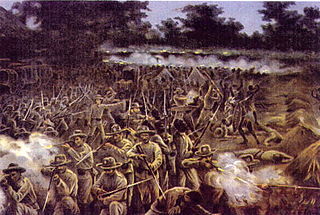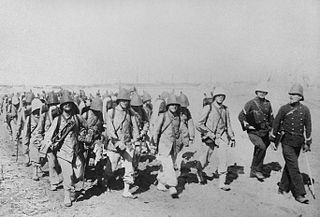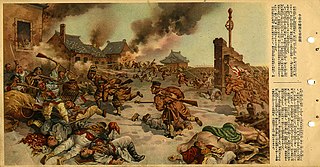 W
WThe Battle of Amba Alagi was the first in a series of battles between the Italian General Baratieri and Ethiopia's Emperor Menelik during the First Italo-Ethiopian War. Amba Alagi was one of Baratieri's forward positions; it was under the command of Major Toselli with 2,000 Eritrean Askari. On 7 December 1895, the Ras Makonnen, Ras Welle Betul and Ras Mengesha Yohannes commanded an assault of Menelik's vanguard that annihilated the Italians and killed Major Toselli.
 W
WThe Batetela rebellion was a series of three military mutinies and a subsequent low-level insurgency which was attributed to members of the Tetela ethnic group in the Congo Free State between 1895 and 1908. Beginning in a mutiny among the troops the Force Publique of Luluabourg in January 1895, the revolt sparked an prolonged insurgency and two further mutinies elsewhere in the Congo. The rebellion was one of the most important anti-colonial rebellions in the history of the Congo and the last Tetela rebels were only defeated in 1901.
 W
WThe Chitral Expedition was a military expedition in 1895 sent by the British authorities to relieve the fort at Chitral which was under siege after a local coup. After the death of the old ruler power changed hands several times. An intervening British force of about 400 men was besieged in the fort until it was relieved by two expeditions, a small one from Gilgit and a larger one from Peshawar.
 W
WThe Battle of Coatit was fought on 13 January 1895 between Italy and Ethiopian proxies led by Tigrian warlord Ras Mengesha Yohannes in what is now Eritrea. It was the opening battle of the First Italo–Ethiopian War, and was a significant victory for the Italians, as they rebuffed an invasion force.
 W
WThe Colombian Civil War of 1895 was a conflict that took place in the Republic of Colombia in the late nineteenth century, then formed by the current countries of Colombia and Panama.
 W
WThe Cuban War of Independence was the last of three liberation wars that Cuba fought against Spain, the other two being the Ten Years' War (1868–1878) and the Little War (1879–1880). The final three months of the conflict escalated to become the Spanish–American War, with United States forces being deployed in Cuba, Puerto Rico, and the Philippine Islands against Spain. Historians disagree as to the extent that United States officials were motivated to intervene for humanitarian reasons but agree that yellow journalism exaggerated atrocities attributed to Spanish forces against Cuban civilians.
 W
WThe Dungan revolt (1895–96) was a rebellion of various Chinese Muslim ethnic groups in Qinghai and Gansu against the Qing dynasty, that originated because of a violent dispute between two Sufi orders of the same sect. The Wahhabi inspired Yihewani organization then joined in and encouraged the revolt, which was crushed by loyalist Muslims.
 W
WThe Federalist Riograndense Revolution (1893–1895) was a civil war which occurred in southern Brazil against the recently-formed Republic. Urged by the political crisis generated by the federalists, an opposition group that sought to liberate Rio Grande do Sul from the governance of Julio de Castilhos, then president of the state, and also gain greater autonomy and decentralize the power of the then newly proclaimed Republic.
 W
WThe First Italo-Ethiopian War was fought between Italy and Ethiopia from 1895 to 1896. It originated from the disputed Treaty of Wuchale, which the Italians claimed turned Ethiopia into an Italian protectorate. Full-scale war broke out in 1895, with Italian troops from Italian Eritrea having initial success until Ethiopian troops counterattacked Italian positions and besieged the Italian fort of Mekele, forcing its surrender.
 W
WThe Hamidian massacres, also referred to as the Armenian Massacres of 1894–1896 and Armenian genocide, were massacres of Armenians in the Ottoman Empire that took place in the mid-1890s. It was estimated casualties ranged from 80,000 to 300,000, resulting in 50,000 orphaned children. The massacres are named after Sultan Abdul Hamid II, who, in his efforts to maintain the imperial domain of the collapsing Ottoman Empire, reasserted Pan-Islamism as a state ideology. Although the massacres were aimed mainly at the Armenians, they turned into indiscriminate anti-Christian pogroms in some cases, such as the Diyarbekir massacre, where, at least according to one contemporary source, up to 25,000 Assyrians were also killed.
 W
WThe Jameson Raid was a botched raid against the South African Republic carried out by British colonial administrator Leander Starr Jameson and his Company troops and Bechuanaland policemen over the New Year weekend of 1895–96. Paul Kruger was president of the republic at the time. The raid was intended to trigger an uprising by the primarily British expatriate workers in the Transvaal but failed to do so. The workers were called the Johannesburg conspirators. They were expected to recruit an army and prepare for an insurrection. The raid was ineffective and no uprising took place. The results included embarrassment of the British government; the replacement of Cecil Rhodes as premier of the Cape Colony; and the strengthening of Boer dominance of the Transvaal and its gold mines. The raid was a contributory cause of the Anglo-Boer War (1899–1902).
 W
WThe Japanese invasion of Taiwan was a conflict between the Empire of Japan and the armed forces of the short-lived Republic of Formosa following the Qing Dynasty's cession of Taiwan to Japan in April 1895 at the end of the First Sino-Japanese War. The Japanese sought to take control of their new possession, while the Republican forces fought to resist Japanese occupation. The Japanese landed near Keelung on the northern coast of Taiwan on 29 May 1895, and in a five-month campaign swept southwards to Tainan. Although their advance was slowed by guerrilla activity, the Japanese defeated the Formosan forces whenever they attempted to make a stand. The Japanese victory at Baguashan on 27 August, the largest battle ever fought on Taiwanese soil, doomed the Formosan resistance to an early defeat. The fall of Tainan on 21 October ended organised resistance to Japanese occupation, and inaugurated five decades of Japanese rule in Taiwan.
 W
WThe Kucheng massacre was a massacre of Western Christians that took place at Gutian Fujian, China on August 1, 1895. At dawn of that day, a fasting folk religious group attacked British missionaries who were then taking summer holidays at Gutian Huashan, killing eleven people and destroying two houses. The Kucheng Massacre is considered one of the worst attacks against foreigners in China prior to the Boxer Movement in 1899–1901, the only comparable event in China's missionary history being the Tianjin Massacre in 1870.
 W
WMarracuene, earlier known as Vila Luísa is a town in Mozambique's Maputo Province in Marracuene District, located 30 km north of Maputo on the Incomati River. The Parque de Campismo de Marracuene, a popular camping destination, is located nearby.
 W
WThe Mat Salleh Rebellion was a series of major armed disturbances against the colonial British North Borneo Chartered Company administration in North Borneo, now the Malaysian state of Sabah. It was instigated by Datu Muhammad Salleh, a local chief from the Lingkabo district and Sugut River. He led the rebellion between 1894 until his death in Tambunan in 1900. The resistance then continued on for another 5 years until 1905.
 W
WThe Peruvian Civil War of 1894–1895 was an internal Peruvian conflict sparked by the election of Andrés Avelino Cáceres to the presidency of Peru. As Nicolás de Piérola and his forces entered the Peruvian capital, Lima, 1,000 people were killed. Cáceres resigned and Piérola became President of Peru.
 W
WThe Pescadores campaign was the last military operation of the First Sino-Japanese War and an essential preliminary to the Japanese conquest of Taiwan.
 W
WThe Second Madagascar expedition was a French military intervention which took place in 1894–95, sealing the conquest of the Merina Kingdom on the island of Madagascar by France. It was the last phase of the Franco-Hova War and followed the First Madagascar expedition of 1883–85.
 W
WThe Supreme Macedonian Committee chetas' action in 1895 was an armed expedition of several chetas from Bulgaria into the Ottoman-ruled Macedonia in the period of June-August 1895. Its aim was to provoke a general uprising in the area and to draw the attention of the Great Powers to non-compliance of the Treaty of Berlin (1878), and the provided reforms in European Turkey. The Supreme Macedonian Committee invited about 40 active and reserve officers from the Bulgarian army, as well as some old vojvodes from Macedonia. Among them were Boris Sarafov, Toma Davidov, Mihail Apostolov, Yordan Venedikov, etc. The number of the rebels was about 800 people, divided into four detachments. After invading Macedonia, the separate detachments headed to Strumica, Melnik and Dospat, respectively, but generally did not achieve much success. The failure of the action caused disagreements in the organization. The Ottoman government took advantage of the attack of the Pomaks populated Dospat and spread information about the atrocities in the European press. The Great Powers did not react as expected to the raising of the Macedonian question and instead of putting pressure on the Ottoman Empire, they put pressure on the Bulgarian government.
 W
WThe Battle of Weihaiwei (Japanese: Ikaiei-no-tatakai was a battle of the First Sino-Japanese War. It took place between 20 January and 12 February 1895 in Weihai, Shandong Province, China between the forces of the Japan and Qing China. In early January 1895, the Japanese landed forces in eastern Shandong positioning forces behind the Chinese naval base at Weihaiwei.
 W
WThe 1895 Wilcox rebellion was a brief war from January 6 to January 9, 1895, that consisted of three battles on the island of Oʻahu, Republic of Hawaii. It was the last major military operation by royalists who opposed the overthrow of the Kingdom of Hawaii.
 W
WThe Battle of Yinkou was a land battle of the First Sino-Japanese War between the forces of Meiji Japan and Qing China, fought outside the treaty port town of Yingkou, Manchuria. It is sometimes referred to as the Battle of Niuzhuang or Newchwang.